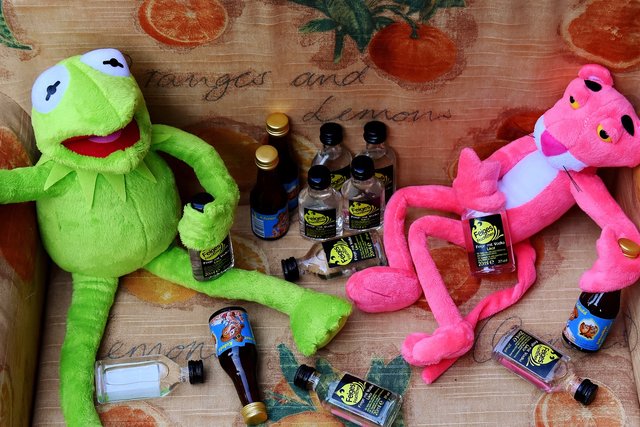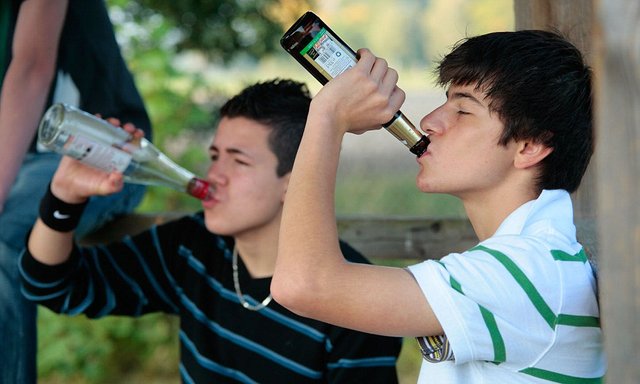Alcoholism in Youths of Today

Credits
Alcohol is a psychoactive substance capable of producing gratification, sedation, tolerance, physical dependence and causing damage to brain structures and other major organs such as the heart and liver. Once ingested, the alcohol molecule is rapidly ABSORBED and DISTRIBUTED in our body, and then METABOLISED from the stomach but above all from the liver that is the organ most exposed to its toxic effects, until its complete ELIMINATION. The DSM IV (Diagnostic and Statistical Manual of Mental Disorders) distinguishes alcohol dependence on alcohol abuse by defining the first pathological condition of the second. Those who depend on alcohol, in fact, show tolerance, which is the result of the adaptation of the substance to the presence of ethanol; altered control, that is the inability to stop or limit oneself in drinking; and psycho-physical dependence which implies a psychological state characterized by a strong craving (desire) for ethanol.
Alcoholism is a disorder with a multifactorial bio-psycho-social genesis: BIOLOGICAL science, current research shows that alcoholism tends to be hereditary. PSYCHOLOGICAL because alcohol abuse is often secondary to psychological distress. And finally, SOCIO-ENVIRONMENT as the environment in which we live and work also influence addiction.

Credits
Risk Factors
The most vulnerable subjects are WOMEN, who, have less water in their body than men, suffer more toxic effects. Furthermore, there is a difference between the sexes also in the average age of onset, usually later in women who are often driven by a psychological motivation unlike the man often induced to dependence on social problems.
Another risk is PREGNANCY and LACKING. If the mother abuses alcoholic beverages during pregnancy, the FAS known as Fetal Alcohol Syndrome may develop in the fetus, which represents the complex of mental and behavioral physical abnormalities inherent to the functional development of a child, caused by alcohol. Risks continue even after birth. Breastfeeding of an ethilist woman, in fact, causes an intoxication in the child. Not C'
Another risk factor is a HISTORY OF ALCOHOL IN FAMILY, often children of alcoholics manifest identification problems, difficulties in expressing themselves, disturbances of their image sometimes phobic, hypochondriacal or hysterical; processing disorders of aggression, affectivity, and also the aggressiveness that often manifests an alcoholic causes a child to assume an obsessive character, which sooner or later will turn into a strong depression and the deep feeling of shame can also induce him to deny the parent's illness, with the intent of preserving a good and strong image that can serve as a reference point. Another risk is the AGE in particular 2 phases of life: ADOLESCENCE and OLD AGE.
The reasons that usually encourage children to take alcohol can be: the pleasure of risk, to transgress, for low self-esteem, or lack of objectives, and especially often for a strong dependence on the group; Older people are also at risk, as it is known that a high consumption of alcohol can lead to memory deficits and therefore increase the possibility of contracting Alzheimer's; Equally harmful is to mix DRUGS and PSYCHOPHARMERS with alcohol which enhance the effects of the latter. This risk is above all common among the elderly, but also among adolescents, who often for "fashion" associate this substance with other drugs.
A last but not least risk factor is the DRIVING OF VEHICLES, alcohol is in fact often the cause of numerous road accidents.

Credits
Acute and chronic effects
Basically the effects of alcohol can be distinguished in acute and chronic. Acute alcoholism is a state of acute intoxication due to excessive intake, in a short time, of alcoholic beverages; Chronic alcoholism is a condition of serious dependency that usually appears after a few years of abuse, and who is subject to it can manifest ALTERATIONS OF PERSONALITY with psychoanalytic symptoms and accentuation of temperamental-character traits. ALCOHOLIC PSYCHOSIS such as delirium of jealousy; alcoholic hallucinosis, a disorder of perception; ALCOHOLIC AMPHASTIC DISTURB such as Wernicke's Encephalopathy, which often occurs after a delirium tremens; and the Korsakoff Syndrome which has a gradual beginning with progressive spatio-temporal disorientation, memory deficits and anterograde amnesia; ALCOHOLIC DEMENCE that manifests itself with disturbances of memory, affectivity and behavior. Finally, a chronic alcoholic can manifest various diseases especially at the hepatic level but also GASTROINTESTINALI, CARDIACHE, HEMATOLOGICAL, NEOPLASTIC and ALTERATION OF IMMUNITY. To understand if a person is subject to alcohol there are SPECIFIC SIGNS to watch out for: how changes in the way of drinking; disorders of the psychic sphere; of the social sphere and physical symptoms such as tremors, lack of appetite, blackout, disturbances in the sexual field and in sleep.

Credits
How to deal with the problem
Some alcoholics work hard to solve the problems they have with alcohol, and often, with the support of their FAMILY GROUP and / or friends, they are able to recover on their own initiative. Yet many, even when they are convinced of their intent, need external help to remain sober; Help that is often requested by family members, precisely because of the attitude of denial, which the alcoholic takes; but sometimes the request comes directly from the employee. This is perhaps the most favorable situation for therapeutic purposes, but also the least frequent. Nowadays, the network of structures that can be addressed is very dense, and there are basically two types of intervention: PROFESSIONAL, which includes the attending physician; the specialist doctor; hospitals and private clinics, the TSDA (Territorial Service Drugs Addiction) and the ONA (Operative nucleus Alcology), which are services of the ASL and provide assistance and information to those who have, or fear they have, problems of alcohol dependency; then there is the NON PROFESSIONAL INTERVENTION, that is, that of the therapeutic communities and recovery centers; self-help groups including the main ones are: AA (Alcoholics Anonymous) based on a recovery program, known as the "Method of the Twelve Steps". One of the firm points of this Association is anonymity. The Al-Anon / Alateen groups are parallel to the AA but completely independent from them, and they meet to discuss the problems that arise from living together with an alcoholic. And finally the CAT (Club Alcoholics in Treatment) which is essentially a multi-family community.
Psychotherapy: phase of diagnosis
According to DSM IV, the diagnosis of Substance-Use Disorder is postponed, it is advisable to carry out an overall assessment of the patient. The results of which will offer a first guide on the choice of the most suitable therapy for the patient. The goals that can be pursued, for therapeutic purposes, can be short, medium and long term. the short-term goals are to help the alcohol dependent person recognize the disease, to admit that he needs help; identifying what to change and translating this understanding into action. Those in the medium term foresee the search for controlled abstinence, with the acceptance of external control tools such as the family or drugs or abstinence agreed with the use of intermediate control tools of a mainly cognitive-behavioral type.
Psychotherapy: treatment phase
The treatments in use to deal with the disease are various, including: Individual Treatment, in which it is essential that the therapist knows how to establish an open and flexible relationship with the patient, so as to include, alongside the psychotherapy, also active interventions such as advice, prohibitions and controls on behavior and, if necessary, resort to the request for admission if necessary.
The Motivational processing , where the responsibility and ability to effect change belong to the patient, and that the therapist's job is to create a set of conditions that can facilitate the patient's motivation.
The Group Privacy, which is based on listening to the problems of the individual thanks to the encouragement and support of people, who share the same thoughts and the same ghosts. The Family or Couple Psychotherapy , which provides that the members are all together to facilitate the explanation of behaviors and encourage the understanding of conscious or unconscious attitudes that may constitute an obstacle to the final achievement of sobriety.

Credits
Drug therapy
And finally the Pharmacological Therapy , Common drugs for the detoxification of alcoholism are the Benzodiazepine very used, because it is readily accepted by the patients. Adverse drugs such as Disulfiram are intended to produce negative conditioning. In case of alcohol intake, in fact, the drug provokes particularly unpleasant reactions, including: nausea, vomiting, tachycardia, redness. While GHB, naltrexone, and neuroleptics appear to have clinically evident anticraving effects. The true stumbling block of alcoholism, once abstinence is achieved, is to not give in to the temptation of alcohol again.
Big Thanks to @enginewitty for this cool Banner
Your Vote can change Everything. Vote Witnesses:




To listen to the audio version of this article click on the play image.

Brought to you by @tts. If you find it useful please consider upvote this reply.
This is indeed a sad reality nowadays.
This post has been curated by TeamMalaysia Community :-
To support the growth of TeamMalaysia Follow our upvotes by using steemauto.com and follow trail of @myach
Vote TeamMalaysia witness bitrocker2020 using this link vote for witness